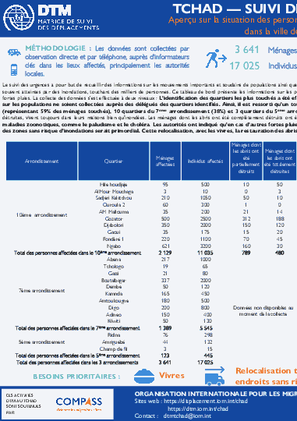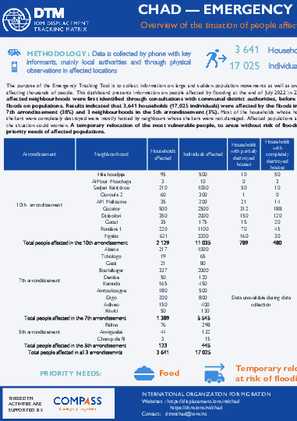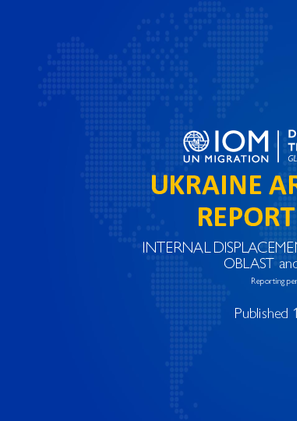-
Countries
-
Data and Analysis
-
Special Focus
-
Crisis Responses

Contact
DTMMozambique@iom.int
Language
English
Location
Mozambique
Period Covered
Jul 01 2022
Jul 30 2022
Activity
- Mobility Tracking
- Event Tracking
During the reporting period (1st - 30 July 2022), a total of 64 movements were recorded - 57 arrivals (887 individuals),
6 departures (41 individuals) and 1 intended return movement (1 individual). The largest individual arrival movements
were recorded in Cidade de Nampula (555 individuals). The largest departure movements were recorded in Moginqual
(23 individuals). Of the total population, 90 per cent of mobile groups were displaced for the first time, and 10
per cent of reported individuals have been displaced more than once prior to this movement

Contact
DTMcovid19@iom.int
Language
English
Location
Global
Period Covered
Aug 01 2022
Aug 05 2022
Activity
- Other
The DTM Global Mobility Restrictions Overview provides updates on international air travel restrictions and conditions for authorized entry. This overview aims to understand how COVID-19 has impacted human mobility, detailing how global and regional trends in air travel measures have evolved since COVID-19 was declared a global pandemic in March 2020. The data presented focuses on the changes in public health-related immigration and border management measures. It provides information intended to support IOM missions and partners in targeted response planning and advocacy for vulnerable populations who may be affected by changes in global mobility.

Contact
DTM Nigeria, AllUsersInDTMNigeria@iom.int
Language
English
Location
Nigeria
Period Covered
Aug 01 2022
Aug 07 2022
Activity
- Mobility Tracking
- Event Tracking
Between 01 and 07 August 2022, a total of 3,843 new arrivals were recorded in Adamawa and Borno States. The new arrivals were recorded at locations in Askira/Uba, Bama, Damboa, Gwoza, Kala Balge, Monguno and Ngala Local Government Areas (LGAs) of the most conflict-affected state of Borno and in Demsa, Fufore, Girei, Gombi, Hong, Lamurde, Maiha, Michika, Mubi North, Numan, Song, Yola North and Yola South LGAs of Adamawa State.
ETT assessments identified the following movement triggers: military operations (1,529 individuals or 40%), improved security (807 individuals or 21%), poor living conditions (475 individuals or 12%), family re-unification (101 individuals or 3%), seasonal farming (455 individuals or 12%), camp closure (243 individuals or 6%) and access to humanitarian support (233 individuals or 6%).

Contact
DTM Tchad, dtmtchad@iom.int
Language
English
Location
Chad
Period Covered
Aug 08 2022
Aug 10 2022
Activity
- Mobility Tracking
- Event Tracking
Le suivi des urgences a pour but de recueillir des informations sur les mouvements importants et soudains de populations ainsi que sur des urgences sécuritaires et climatiques. Chaque année au Tchad, durant la saison pluvieuse (juin-septembre), plusieurs localités sont souvent atteintes par des inondations, touchant des milliers de personnes. Ce tableau de bord présente les informations sur les personnes affectées par des inondations survenues en fin de mois de juillet 2022 dans 23 quartiers de la ville de N’Djamena, à la suite de fortes pluies. La collecte des données s’est effectuée à deux niveaux : L’identification des quartiers les plus touchés a été effectuée auprès des autorités communales des arrondissements, avant que les informations sur l’impact des inondations sur les populations ne soient collectées auprès des délégués des quartiers identifiés. Ainsi, il est ressorti qu’un total de 3 641 ménages (17 025 individus) ont été affectés par les inondations.

Contact
DTM Chad, dtmtchad@iom.int
Language
English
Location
Chad
Period Covered
Aug 08 2022
Aug 10 2022
Activity
- Mobility Tracking
- Event Tracking
The purpose of the Emergency Tracking Tool is to collect information on large and sudden population movements as well as on security and climate emergencies. Each year in Chad, during the rainy season (June-September), many localities are often hit by floods, affecting thousands of people. This dashboard presents information on people affected by flooding at the end of July 2022 in 23 neighborhoods in the city of N'Djamena, following heavy rains. The data collection was carried out at two levels: the most
affected neighbourhoods were first identified through consultations with communal district authorities, before surveys were conducted with delegates of the identified neighbourhoods to collect information on the impact of the floods on populations. Results indicated that 3,641 households (17,025 individuals) were affected by the floods.

Contact
DTMUkraine@iom.int
Language
Ukrainian
Location
Ukraine
Period Covered
Jul 25 2022
Aug 05 2022
Activity
- Baseline Assessment
Починаючи з 24 лютого 2022 року війна в Україні спричинила безпрецедентну гуманітарну кризу в усіх адміністративних підрозділах (областях) країни.
З 24-го липня по 5 сепрня Міжнародна організація з міграції (МОМ) провела базову оцінку території 914 громад, які приймають зареєстрованих внутрішньо переміщених осіб у 19 областях та в місті Києві, щоб отримати загальне уявлення про внутрішнє переміщення.
Проведення цієї оцінки підтримує цільове призначення та надання гуманітарної допомоги постраждалим населенням і служить попереднім джерелом для виявлення громад з високим рівнем переміщення.

Contact
DTMUkraine@iom.int
Language
English
Location
Ukraine
Period Covered
Jul 25 2022
Aug 05 2022
Activity
- Baseline Assessment
Starting on 24 February 2022, the war in Ukraine triggered an unprecedented humanitarian crisis across the country. Between 25 July and 5 August the International Organization for Migration (IOM) conducted an area baseline assessment of 914 hromadas* hosting IDPs in Kyivska, Dnipropetrovska, Poltavska, Vinnytska, Zakarpatska, Cherkaska, Lvivska, Khmelnytska, Ivano-Frankivska, Ternopilska, Odeska, Kirovohradska, Chernivetska, Zhytomyrska, Zaporizka, Chernihivska, Volynska, Rivnenska, Sumska oblasts and Kyiv city in order to gather initial trends on the number and geographic location of officially recorded internally displaced persons.
This routine assessment supports the targeting and provision of humanitarian assistance to the affected populations and serves as a preliminary source to identify oblasts and hromadas hosting high numbers of IDPs.
In Round 9 of DTM’s Area Baseline, IOM compiled information on more than 2,500,000 IDPs in 19 oblasts and Kyiv city.

Contact
DTM Türkiye, dtmturkey@iom.int
Language
English
Location
Republic of Türkiye
Period Covered
Jul 01 2022
Jul 31 2022
Activity
- Flow Monitoring
According to the latest available figures from the Turkish Presidency of Migration Management (PMM), there are more than 5* million foreign nationals present in Turkish territory, 3.6* million of whom are seeking international protection. Most are Syrians (3,652,633* individuals) who are granted temporary protection status. In addition, international protection applicants from countries including Afghanistan, the Islamic Republic of Iran and Iraq constitute another group of foreign nationals. According to PMM, there were 29,256* international protection applicants present in Türkiye in 20211, published annually. Moreover, according to UNHCR**, there are close to 330,000 international protection status holders and asylum-seekers. The number of foreign nationals has decreased by 42,282 in comparison to July 2021 (3.7 million foreign nationals).
In addition, there are 1,411,928* foreign nationals present in Türkiye holding residency permits, including humanitarian residency holders. Compared to July 2021, this is an increase of 244,065 individuals. The exact number of humanitarian residency holders is unknown, but it is estimated that there are more than several thousand humanitarian residency permit holders.
*Data source PMM, 28.07.2022
**Data source UNHCR, December 2021

Contact
DTM Turkey, dtmturkey@iom.int
Language
English
Location
Republic of Türkiye
Period Covered
Jul 01 2022
Jul 31 2022
Activity
- Flow Monitoring
- Migrants presence
- Mobility Tracking
According to the latest available figures from the Turkish Presidency of Migration Management (PMM), there are more than 5* million foreign nationals present in Turkish territory, 3.6* million of whom are seeking international protection. Most of those seeking international protection are Syrians (3,652,633* individuals) who are granted the temporary protection status in Türkiye. In addition, international protection applicants are most frequently nationals of Afghanistan, the Islamic Republic of Iran and Iraq constitute another group of foreign nationals. According to PMM, there were 29,256* international protection applicants present in Türkiye in 20211, published annually. Moreover, according to UNHCR**, there are close to 330,000 international protection status holders and asylum-seekers.
In addition, there are 1,411,928* foreign nationals under residence permit holder status; this number includes humanitarian residence holders.
*Data Source PMM, 28.07.2022
**Data source UNHCR, December 2021

Contact
DTM Europe, DTMMediterranean@iom.int
Language
English
Location
Republic of Moldova
Period Covered
Feb 24 2022
Aug 01 2022
Activity
- Flow Monitoring
- Migrants presence
Between 24 February and 1 August 2022, Ukrainian refugees represent 92 per cent (508,353) of all individuals registered at entry from Ukraine (UKR) to the Republic of Moldova (MDA). The remaining eight per cent (47,062) are other TCNs. Similarly, Ukrainian refugees represent 90 per cent (290,403) of all individuals registered while leaving the Republic of Moldova towards Romania during the reporting period and the remaining 10 per cent (32,829) are TCNs.
This report focuses on trends of TCNs from Ukraine to the Republic of Moldova, analyzing data about their stay or their subsequent movement out of the country.
